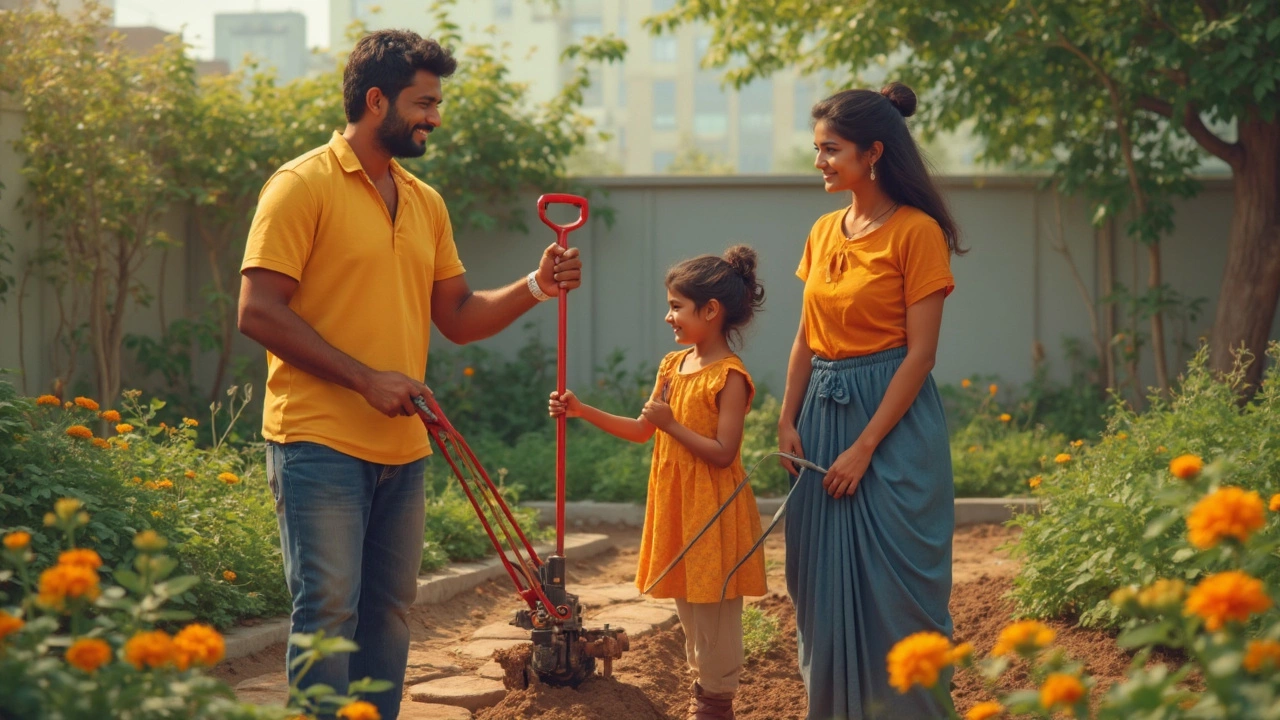Ever spent an afternoon hacking at hard soil with the wrong tool? Yeah, same here. Getting your garden soil ready is a pain if you use the wrong gear, but when you pick the right tool, it feels like cheating. Tilling isn’t just about breaking up dirt; it’s about giving your plants the best shot at healthy roots and easy watering. If you ignore this step, you’re setting yourself up for weak plants and more headaches down the road.
So what tool should you reach for? The short answer: it depends on your soil, the size of your garden, and how much elbow grease you want to use. Some backyards call for a simple hand tool, others really need a machine. Skip the guesswork—I’ll walk you through the options, why they work (or don’t), and how to pick based on your space. Whether you’re working a tiny patch or you’re planning a whole row of tomatoes and squash, there’s a tool that’ll make the job faster, easier—and way less brutal on your lower back.
- What Does It Mean to Till Soil?
- Hand Tools for Small Gardens
- Power Tillers and When to Use Them
- Tips for Easier and Safer Tilling
What Does It Mean to Till Soil?
Tilling soil just means digging it up and turning it over so you can break up chunks and get air pockets rolling through the dirt. This can sound simple, but there’s a bit of art (and science) behind it. Tilling is done to loosen soil, mix in things like compost or old plants, and create space for roots to push down deep. When that soil's all packed down or crusty up top, roots just hit a wall.
Most folks till because it makes planting easier and helps water soak in. It’s also a solid way to bust up weeds before they have a chance to cause trouble. Healthy, loose earth just grows better veggies, end of story.
There’s a sweet spot, though. Tilling too deep or too much can actually mess with the good stuff that’s already happening down there, like natural worm tunnels or all those little bugs breaking down plant leftovers. According to the University of Minnesota Extension,
"Frequent or deep tillage disrupts soil structure, harms earthworm populations, and can actually make soil more prone to crusting and erosion."That’s a fancy way of saying don’t attack your dirt with a rototiller like you’re on a mission—just loosen it enough for roots to breathe and soak up nutrients.
The key thing to remember? Tilling is all about prepping your garden for a fresh start. It helps seeds get settled, gives water a straight shot to the roots, and cuts down on weed drama. And if you pick the right till soil tool, you set yourself up for a much less stressful season.
Hand Tools for Small Gardens
If your garden isn’t much bigger than a parking space, there’s no need to lug around heavy machinery. Hand tools are perfect for small plots, raised beds, or container gardens. They let you work close to your plants and have more control, which is a lifesaver when you’ve got delicate roots or cramped corners to deal with.
The must-haves are simple: a hand trowel for digging, a garden fork for breaking up soil, and a hoe for cutting weeds and loosening the top layer. For tougher jobs, the classic manual cultivator, sometimes called a claw, can shred through compacted soil like nobody’s business. If you ever grew up watching someone garden, you probably saw these tools at work — and for good reason, they’ve hardly changed in generations.
Here are the most popular hand tools you’ll see for tilling soil in small gardens:
- Till soil using a hand cultivator or claw: Great for loosening soil about 2-4 inches deep; best for lighter ground.
- Garden fork: Thin, sturdy tines break up clumps and can dig a little deeper. Look for stainless steel to avoid bent tines.
- Hand trowel: Good for scooping, transplanting, and scraping the surface.
- Hoe: Use a stirrup hoe or regular hoe to scrape off weeds and break up crusty topsoil.
Cheap tools don’t hold up. When you shop, grab ones with solid handles (wood or fiberglass) and try them out in your hand for comfort. Milo and I once bought a bargain trowel at a big box store. The handle snapped during its first battle with our rocky beds. It’s worth spending a few extra bucks on quality—less frustration, less landfill junk.
| Hand Tool | Best Use | Average Price (2025) | Depth Reached |
|---|---|---|---|
| Cultivator Claw | Loosening & mixing soil | $10–$25 | 2–4 inches |
| Garden Fork | Breaking up heavy soil | $20–$40 | 6–8 inches |
| Hand Trowel | Planting & scooping | $8–$15 | 4–6 inches |
| Hoe | Weeding & topsoil prep | $12–$25 | up to 2 inches |
Here’s a tip: If your soil is super hard, water it the night before. It makes life way easier, whether you’re 8 years old like Milo or full-grown and avoiding a sore wrist. And don’t rush—short, quick sessions beat one backbreaking afternoon every time. Small gardens are supposed to be fun, not frustrating.

Power Tillers and When to Use Them
Here’s where things get a whole lot easier—or a lot louder, depending on how you look at it. Power tillers are machines that dig and turn over the ground for you. They take most of the muscle out of yard work, especially when you’re dealing with big plots, packed soil, or turning over last year’s garden patch. These machines can save you a day (or three) of sore arms if you pick the right type.
Basically, power tillers split into two major groups: front-tine and rear-tine. The front-tine models are lighter, cheaper, and good for smaller jobs, like flower beds or veggie plots up to around 1,500 square feet. Rear-tine tillers bring more power and stability, making them better for hard, rocky, or really large gardens.
Here’s a quick side-by-side breakdown, so you know what you’re working with:
| Type | Best For | Weight | Average Price (USD) |
|---|---|---|---|
| Front-tine Tiller | Small/medium gardens, lighter soil | 20-75 lbs | $250-$450 |
| Rear-tine Tiller | Large gardens, tough ground | 175-300 lbs | $800-$2,000 |
Electric tillers are also out there, and they’re a solid pick if you don’t want to mess with gas, fumes, or loud engines. They’re quieter, lighter, and you can usually store them in small sheds. But don’t expect them to chew through clay or rocky soil—they’re best on small, already softened areas.
So when should you break out a till soil machine? Here’s the lowdown:
- If your soil is hard, rocky, or packed tight and a shovel just bounces right off—it’s time for power.
- If you’re working on a garden bigger than a little raised bed, especially if it’s bigger than 500 square feet, a power tiller is a huge time-saver.
- If you plan to break new ground where grass or weeds have grown for years, you’ll thank yourself for using a tiller with muscle.
One big tip: always check your soil moisture first. Soggy dirt will gum up the tines and compact the earth, while bone-dry soil will turn to dust and blow away. Aim for soil that feels like a wrung-out sponge—it sticks together, but isn’t sticky or sloppy.
If you’re not sure what size tiller you need, a lot of hardware stores rent them for an afternoon. Try renting before buying, especially if you only till once a year. And if you have neighbors with gardens, see if you can share or split the cost. Power tillers cost a chunk of change, but they’ll last years if you keep up with oil checks and clean them after use.
Tips for Easier and Safer Tilling
It’s tempting to grab the biggest tiller and dive in, but tiling the right way keeps your soil—and your back—in good shape. Even if you’re using the best tool to till soil, a few smart tweaks make the work way simpler and cut your risk of injury.
- Time it right: Soil’s easier to work when it’s moist, but not soggy. A quick trick? Grab a handful and squeeze. If it sticks together and drips, it’s too wet. If it falls apart, you’re good to go.
- Check for wires and roots: Before you dig in, move any hoses, wires, or big sticks out of the way. If you hit a root or rock with a tiller, you’ll feel it in your hands—sometimes way too much.
- Don’t till too deep: Most plants like the top 6-8 inches worked up. Anything deeper just wastes effort and brings up weed seeds that cause headaches later.
- Work in rows: Tilling in straight rows keeps you from missing spots and makes it easier to keep the blade level. It also means you’re moving efficiently instead of zigzagging all over the place.
- Let the tool do the work: Especially with machines, don’t force it. Pushing too hard just leads to sore arms and a cranky back. Let it tug you forward and keep your grip relaxed.
- Wear the right stuff: Gloves, sturdy shoes, and long pants save your skin. Even Milo, who likes to "supervise," knows flip-flops are a no-go (learned that one the hard way).
Wondering how much time you’ll save using a tiller vs. digging by hand? Here’s a quick breakdown:
| Method | Average Time for 100 sq ft (minutes) | Energy Level After |
|---|---|---|
| Hand Tiller | 60-90 | Wiped out |
| Rotary Tiller (Electric) | 15-25 | Still moving |
| Rotary Tiller (Gas) | 10-20 | Fine, maybe sore hands |
Last thing—never till when kids or pets are nearby. Blades can kick up rocks or chunks of earth that turn into missiles. A little caution goes a long way, and you’ll keep everyone smiling instead of heading to the urgent care.

